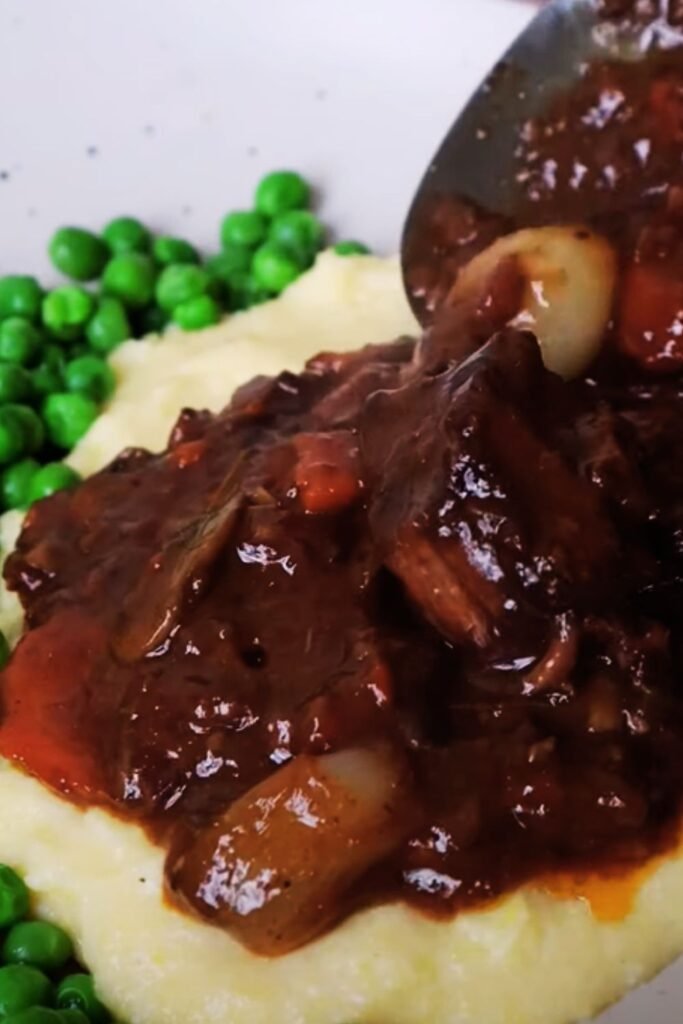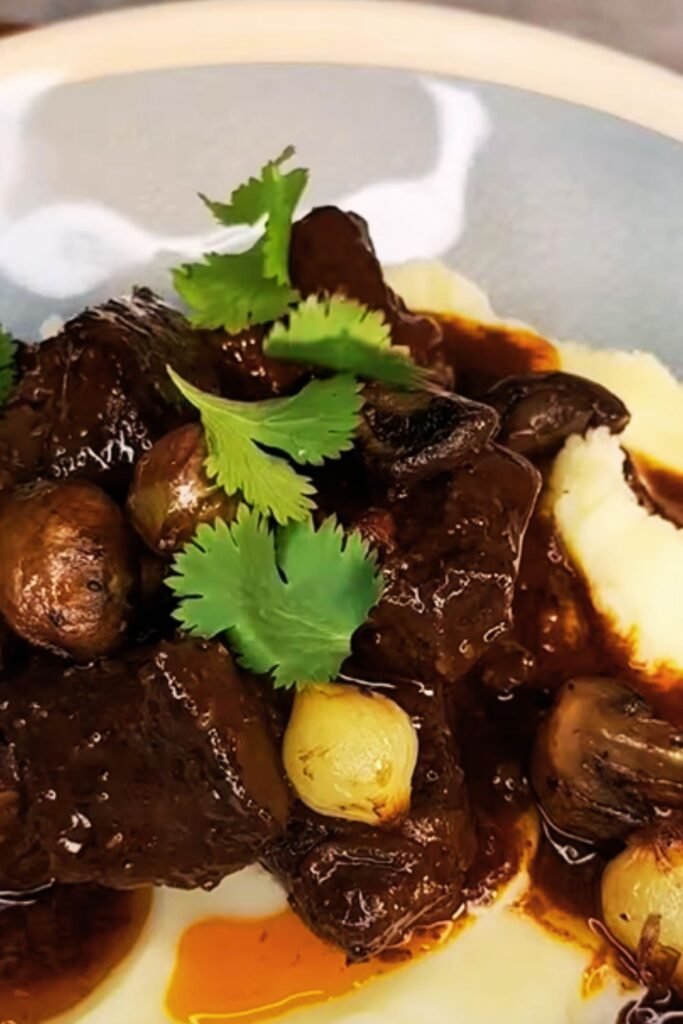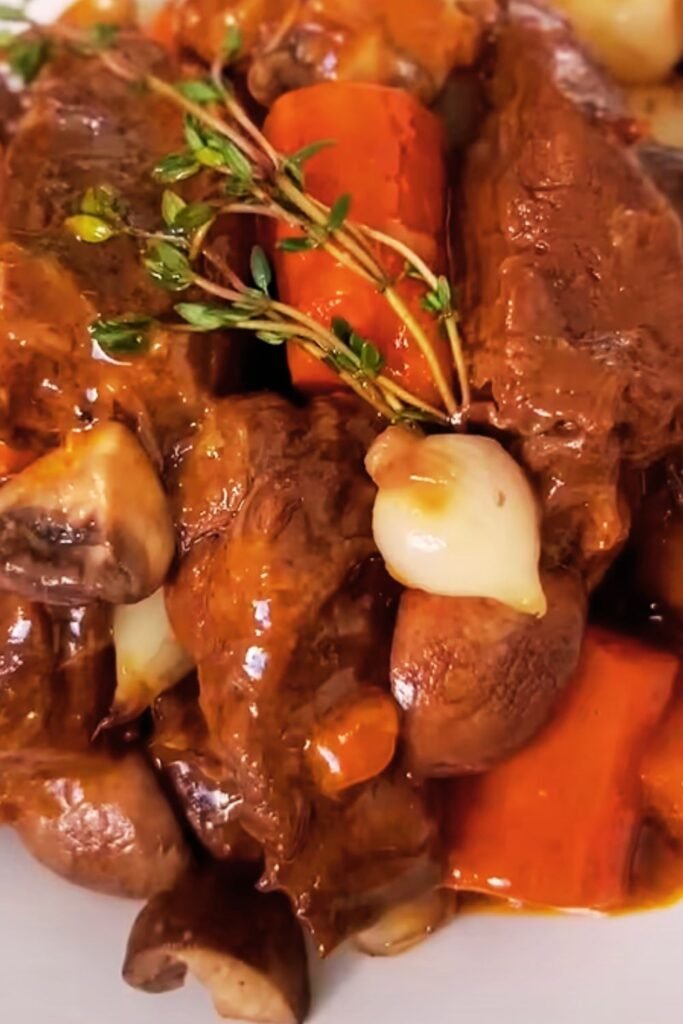When I first attempted beef bourguignon in my own kitchen, I’ll admit I was intimidated. This iconic French dish, with its rich burgundy sauce and tender chunks of beef, seemed like something only professional chefs could master. However, after years of perfecting my technique and understanding the nuances of this classic recipe, I can confidently say that beef bourguignon is not only achievable for home cooks but absolutely worth the effort.
The beauty of beef bourguignon lies in its simplicity disguised as complexity. At its core, this dish is essentially a beef stew elevated through careful technique, quality ingredients, and patience. What makes it special is the slow braising process that transforms tough cuts of beef into fork-tender morsels swimming in a velvety, wine-enriched sauce that’s been infused with aromatic vegetables and herbs.
Understanding Beef Bourguignon: More Than Just a Stew
Beef Bourguignon (pronounced “bœuf bourguignon” in French) is a traditional French braised beef dish that originated in the Burgundy region of France. The dish combines beef braised in red wine with vegetables, herbs, and traditionally, lardons (small strips of pork fat or bacon).
Braising is a combination cooking method that involves both dry and moist heat. The beef is first seared at high temperature, then finished in a covered pot with liquid at a lower temperature.
Burgundy Wine refers to wines produced in the Burgundy region of eastern France, though any good-quality dry red wine can be substituted in modern recipes.
Mirepoix is the French culinary term for a mixture of diced vegetables (typically onions, carrots, and celery) used as a flavor base for many dishes.
The Essential Ingredients That Make All the Difference
My experience has taught me that the quality of ingredients directly impacts the final dish. Here’s what I always use:
Primary Ingredients
| Ingredient | Quantity | Purpose | Quality Tips |
|---|---|---|---|
| Chuck roast or beef short ribs | 3-4 lbs | Main protein | Look for well-marbled meat with good fat distribution |
| Dry red wine | 1 bottle (750ml) | Braising liquid | Choose something you’d drink; avoid “cooking wine” |
| Thick-cut bacon | 6-8 strips | Flavor base | Use quality bacon, not thin breakfast strips |
| Pearl onions | 1 lb | Vegetables | Fresh is best, but frozen works in a pinch |
| Mushrooms (cremini or button) | 1 lb | Vegetables | Choose firm, fresh mushrooms without dark spots |
| Carrots | 3-4 large | Vegetables | Look for firm, bright orange carrots |
| Garlic | 1 whole head | Aromatics | Fresh garlic only – no pre-minced |
| Tomato paste | 2 tablespoons | Umami depth | Double-concentrated paste works best |
| Beef stock | 2-3 cups | Additional liquid | Low-sodium, high-quality stock |
| Fresh thyme | 4-5 sprigs | Herbs | Fresh herbs make a noticeable difference |
| Bay leaves | 2-3 leaves | Aromatics | Dried bay leaves are fine |
| All-purpose flour | 1/4 cup | Thickening | For dusting beef and thickening sauce |
Supporting Cast
| Ingredient | Quantity | Purpose |
|---|---|---|
| Butter | 4 tablespoons | Finishing and sautéing |
| Olive oil | 2 tablespoons | Searing |
| Fresh parsley | 1/2 cup chopped | Garnish |
| Salt and black pepper | To taste | Seasoning |
My Step-by-Step Method for Perfect Beef Bourguignon

Phase 1: Preparation and Setup (30 minutes)
I always start by preparing all my ingredients before I begin cooking. This French technique called “mise en place” ensures smooth cooking without scrambling for ingredients mid-process.
- Cut the beef into 2-inch cubes, removing any large pieces of fat or gristle
- Pat the meat dry with paper towels – this is crucial for proper searing
- Season generously with salt and pepper
- Dust lightly with flour, shaking off excess
- Dice the bacon into small pieces
- Peel and trim the pearl onions (blanch in boiling water for 2 minutes to make peeling easier)
- Slice the mushrooms into thick pieces
- Dice the carrots into 1-inch pieces
- Mince the garlic
Phase 2: Building the Flavor Foundation (45 minutes)
This is where the magic begins. I use a heavy-bottomed Dutch oven or enameled cast iron pot for even heat distribution.
- Cook the bacon over medium heat until crispy and fat is rendered
- Remove bacon with a slotted spoon, leaving the fat in the pot
- Increase heat to medium-high and sear the beef in batches
- Don’t overcrowd – this causes steaming instead of searing
- Sear each side for 2-3 minutes until deep brown
- Remove beef and set aside
- Sauté the vegetables in the same pot: onions first, then carrots, then mushrooms
- Add garlic and tomato paste for the last minute of cooking
Phase 3: The Braising Process (2.5-3 hours)
This is where patience pays off. Low and slow cooking transforms tough connective tissue into gelatin, creating that silky sauce texture.
- Return beef and bacon to the pot
- Add wine and scrape up any browned bits from the bottom
- Bring to a simmer and let alcohol cook off (about 5 minutes)
- Add herbs and bay leaves
- Add enough stock to barely cover the meat
- Bring to a gentle simmer on the stovetop
- Cover and transfer to a 325°F oven
- Cook for 2.5-3 hours until meat is fork-tender
Mastering the Technique: Common Mistakes I’ve Learned to Avoid
Temperature Control Issues
| Problem | Cause | Solution |
|---|---|---|
| Tough, chewy meat | Temperature too high | Keep oven at 325°F maximum |
| Dry meat | Overcooking | Test with fork at 2-hour mark |
| Watery sauce | Insufficient searing | Properly brown meat and vegetables |
| Bitter taste | Burnt fond | Control heat during searing |
Liquid Management
The liquid level is crucial. I’ve learned that too much liquid dilutes flavors, while too little can cause burning. The liquid should just barely cover the meat at the beginning of braising.
Vegetable Timing
Adding all vegetables at once was my early mistake. Pearl onions and mushrooms need different cooking times. I now add pearl onions during the last hour of cooking and mushrooms during the last 30 minutes to maintain their texture.

Advanced Tips for Restaurant-Quality Results
Wine Selection Strategy
I always cook with wine I’d drink. The alcohol evaporates, but the flavor concentrates. My go-to choices include:
- Côtes du Rhône for earthy, robust flavor
- Pinot Noir for lighter, more delicate notes
- Cabernet Sauvignon for bold, structured taste
Sauce Perfection Techniques
The sauce should coat the back of a spoon when finished. If it’s too thin, I remove the meat and vegetables, then reduce the liquid on the stovetop. If it’s too thick, I add a bit more stock.
Make-Ahead Advantages
Beef bourguignon actually improves with time. I often make it a day ahead, which allows:
- Flavors to meld and deepen
- Easy fat removal from the surface
- Stress-free entertaining
Nutritional Profile and Health Considerations
Nutritional Breakdown (per serving, serves 6)
| Nutrient | Amount | % Daily Value |
|---|---|---|
| Calories | 485 | 24% |
| Protein | 42g | 84% |
| Fat | 18g | 28% |
| Carbohydrates | 12g | 4% |
| Fiber | 2g | 8% |
| Iron | 4.2mg | 23% |
| Vitamin A | 184mcg | 20% |
| Vitamin C | 8mg | 9% |
Health Benefits
The slow cooking process breaks down tough connective tissues, making the protein more digestible. The vegetables provide essential vitamins and minerals, while the moderate fat content aids in nutrient absorption.
Serving Suggestions and Accompaniments
Traditional Pairings
- Mashed potatoes – classic and comforting
- Egg noodles – absorb the sauce beautifully
- Crusty French bread – perfect for sauce-sopping
- Roasted root vegetables – complement the earthy flavors
Modern Serving Ideas
- Polenta – creamy and elegant
- Cauliflower mash – lighter alternative
- Wild rice pilaf – adds nutty flavor
- Grilled asparagus – fresh contrast
Presentation Tips
I always finish with fresh chopped parsley and serve in warmed bowls. The contrast of green herbs against the rich, dark sauce creates an appetizing presentation.
Storage and Reheating Guidelines
Refrigeration
Beef bourguignon keeps for 3-4 days in the refrigerator. I store it in the cooking pot or transfer to airtight containers.
Freezing
This dish freezes beautifully for up to 3 months. I freeze in portion-sized containers for easy reheating.
Reheating Methods
| Method | Time | Temperature | Notes |
|---|---|---|---|
| Stovetop | 15-20 minutes | Low heat | Stir occasionally, add liquid if needed |
| Oven | 30-40 minutes | 325°F | Cover with foil |
| Microwave | 5-8 minutes | Medium power | Stir every 2 minutes |

Variations and Creative Adaptations
Regional Variations
- Beef Bourguignon Blanc – uses white wine instead of red
- Coq au Vin – chicken version of the same technique
- Venison Bourguignon – game meat variation
Dietary Adaptations
- Gluten-free – omit flour dusting, thicken with cornstarch slurry
- Lower sodium – use low-sodium stock and reduce salt
- Lighter version – trim all visible fat, use turkey bacon
Troubleshooting Common Issues
Problem-Solution Guide
Sauce too thin: Remove meat and vegetables, reduce liquid on stovetop by simmering uncovered.
Sauce too thick: Add warm stock gradually until desired consistency.
Meat still tough: Continue cooking – some cuts need longer than others.
Vegetables mushy: Add delicate vegetables later in cooking process.
Lack of flavor: Check seasoning, may need more salt or herbs.
The Science Behind the Perfect Bourguignon
Understanding the cooking science helps achieve consistent results. The Maillard reaction during searing creates complex flavors, while slow braising converts collagen to gelatin, creating the signature silky texture. The acid in wine helps tenderize the meat while adding depth to the sauce.
Seasonal Considerations and Ingredient Substitutions
Winter Adaptations
During colder months, I add root vegetables like parsnips and turnips for extra heartiness.
Summer Variations
In warmer weather, I serve smaller portions with lighter sides like herb-roasted new potatoes.
Ingredient Substitutions
- No pearl onions: Use regular onions cut into chunks
- No mushrooms: Double the carrots or add celery
- No bacon: Use olive oil for cooking, add smoked paprika for depth
Q&A Section
Q: How long does beef bourguignon take to cook? A: The total cooking time is approximately 4-5 hours, including 30 minutes of prep, 45 minutes of initial cooking, and 2.5-3 hours of braising in the oven.
Q: Can I make beef bourguignon in a slow cooker? A: Yes, but I recommend searing the meat and sautéing vegetables first for better flavor. Then transfer to a slow cooker and cook on low for 6-8 hours.
Q: What’s the best cut of beef for bourguignon? A: Chuck roast is my preferred choice because it has excellent marbling and becomes incredibly tender when braised. Short ribs and brisket also work well.
Q: Do I need to use expensive wine? A: No, but use wine you’d drink. Avoid “cooking wine” which contains added salt. A decent bottle under $15 works perfectly.
Q: Can I make this dish ahead of time? A: Absolutely! Beef bourguignon tastes even better the next day. Make it completely, cool, and refrigerate. Reheat gently before serving.
Q: Why is my sauce not thick enough? A: This usually happens when the meat wasn’t properly floured or if too much liquid was added. Remove the meat and vegetables, then simmer the sauce uncovered to reduce and thicken.
Q: How do I know when the beef is done? A: The meat should be fork-tender, meaning it easily falls apart when pierced with a fork. If it’s still tough, continue cooking and check every 30 minutes.
Q: Can I freeze beef bourguignon? A: Yes, it freezes excellently for up to 3 months. Thaw overnight in the refrigerator and reheat gently on the stovetop.
Q: What should I serve with beef bourguignon? A: Traditional accompaniments include mashed potatoes, egg noodles, or crusty bread. For a lighter option, try polenta or cauliflower mash.
Q: How can I make the dish less heavy? A: Trim all visible fat from the meat, use turkey bacon instead of regular bacon, and serve with lighter sides like steamed vegetables or a simple salad.
Beef bourguignon represents the pinnacle of comfort food – a dish that transforms simple ingredients into something extraordinary through technique, patience, and love. My journey with this recipe has taught me that cooking isn’t just about following instructions; it’s about understanding the why behind each step and adapting the method to your own kitchen and preferences.
The beauty of mastering beef bourguignon lies not just in the final dish, but in the confidence it builds. Once you’ve successfully navigated the searing, braising, and sauce-making, you’ll find yourself approaching other complex recipes with greater assurance. This dish has become my go-to for special occasions, cold winter nights, and any time I want to create something truly memorable in my kitchen.
Remember, every great cook started with their first attempt. Your beef bourguignon might not be perfect the first time, but with each iteration, you’ll better understand the nuances of this classic dish. The key is to embrace the process, trust your instincts, and most importantly, enjoy the incredible aromas that will fill your kitchen as this masterpiece slowly transforms in your oven.